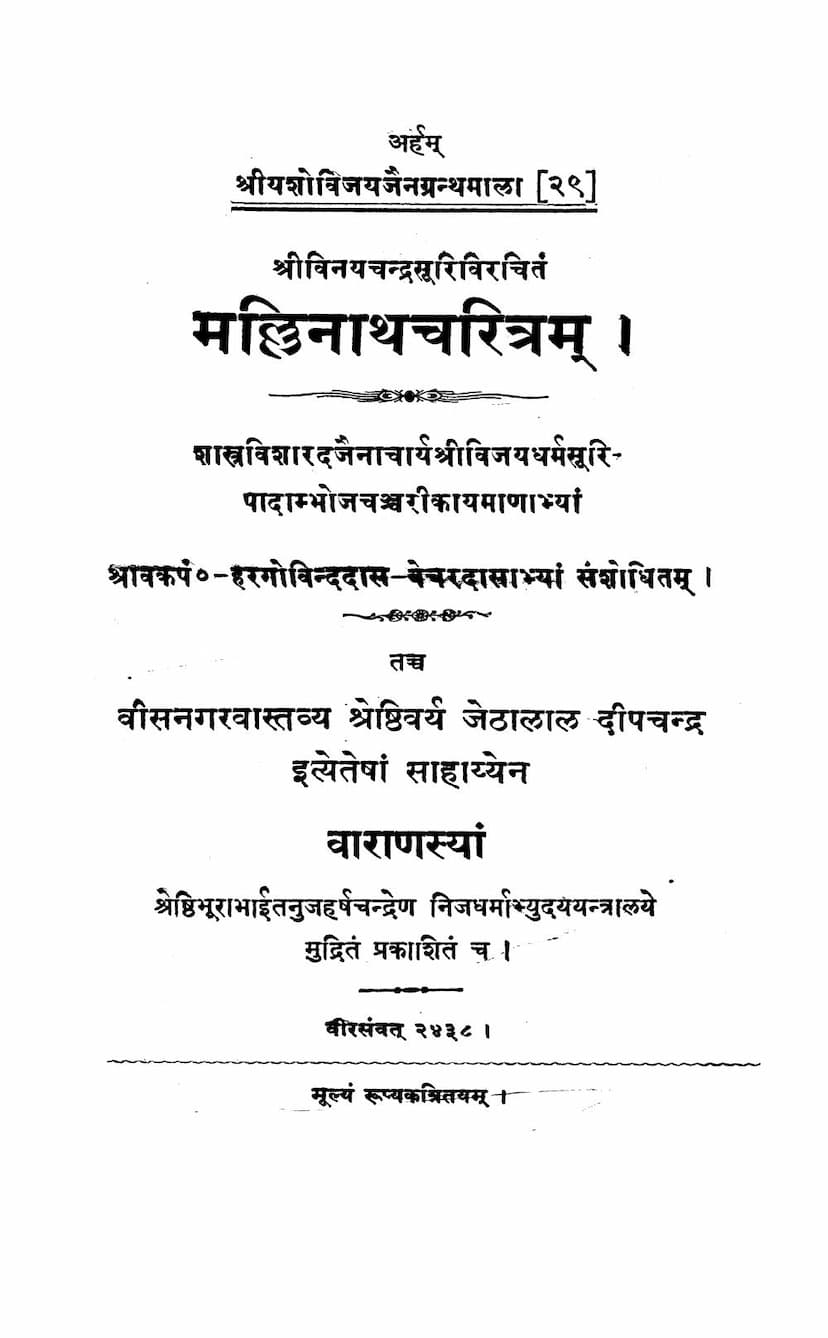Mallinatha Charitra
Added to library: September 2, 2025

Summary
This is a comprehensive summary of the Jain text "Mallinatha Charitra" by Shree Vinaya Chandra Suri, based on the provided text and catalog link.
Book Title: Mallinatha Charitra Author: Shree Vinaya Chandra Suri Editors: Shravak Pandit Hargovinddas and Shravak Pandit Bechardas Publisher: Harshchand Bhurabhai, Dharmabhyudaya Press, Benares Yashovijaya Jaina Granthamala Series: 29
Overall Summary:
The "Mallinatha Charitra" is a mahakavya (great epic poem) composed by the learned Jain Acharya Shree Vinaya Chandra Suri. The text details the life story of Lord Mallinatha, the 19th Tirthankara of Jainism. The epic is meticulously edited and compiled by Shravak Pandit Hargovinddas and Shravak Pandit Bechardas, who are described as devoted servants of His Holiness Shastra Visharad Jainacharya Shree Vijaya Dharma Suri. The publication was made possible through the financial assistance of Jethalal Dipchand Pari of Visnagar, and printed and published by Harshchand Bhurabhai in Benares, Veer Era 2438.
The "Mallinatha Charitra" is highly regarded for its poetic excellence, inclusion of various literary embellishments (alankaras), and rich descriptions of events, characters, and philosophical concepts. It aims to enlighten and guide followers towards spiritual liberation.
Key Aspects and Content:
-
Authorship and Lineage:
- The text traces the lineage of the author, Shree Vinaya Chandra Suri, through several prominent Acharyas, including Shree Vijaya Dharma Suri, Shree Narendraprabh Suri, Shree Devananda, Shree Ratnaprabha, and Shree Kanakprabha.
- The editors, Hargovinddas and Bechardas, express deep devotion to Shree Vijaya Dharma Suri.
- The text also mentions the significant contribution of Shree Pradyumna Suri as a reviser (shodhak), known for his skill in refining texts.
-
Theological and Philosophical Content:
- The "Mallinatha Charitra" is presented as a guide for spiritual upliftment and the attainment of moksha (liberation).
- It emphasizes the principles of Jainism, including dharma, dana (charity), sheela (virtue), tapa (penance), and bhavana (meditation).
- The text highlights the transient nature of worldly pleasures and the importance of detachment from worldly possessions and relationships, drawing parallels with stories of past lives and the consequences of actions (karma).
- It discusses various philosophical concepts, the cyclical nature of existence (samsara), and the path to overcoming it through right faith, knowledge, and conduct.
-
Narrative and Literary Style:
- The "Mallinatha Charitra" follows the conventions of a mahakavya, incorporating various literary styles and elements.
- The text is divided into several sargas (cantos), each detailing specific episodes in the life of Lord Mallinatha and related narratives.
- The language used is Sanskrit, rich in vocabulary and poetic imagery, aiming to evoke emotional responses and deeper understanding in the reader.
- The introductory section (Prastavana) extensively quotes from the "Prashasti" (eulogy) which praises the author and his predecessors, providing historical context and establishing the significance of the work.
- The "Prashasti" also includes details about the era of Shree Vinaya Chandra Suri, placing him around the 12th to 13th century AD.
- The text mentions the inclusion of numerous illustrative stories (kathana) from past lives to explain the virtues and principles of Jainism, such as the stories of Jinadatta, Vanmala, Shree Mahabal, Shree Shalibhadra, and others.
-
Structure and Cantos:
- The provided index (Anukramanika) outlines the structure of the "Mallinatha Charitra," indicating the following cantos and their subjects:
- 1st Sarga: Mangalacharan (invocation), Introduction to the text, Bodha of King Balan (with examples of Pratyeka Buddha Shree Ratnachandra and Satyaharishchandra).
- 2nd Sarga: Description of Dana, Sheela, Tapa, and Bhavana, including the stories of Jinaldatta, Vanmala, King Shree Vidyavilas, and Maharishi Shree Dridha Pratilhari, and the royal asceticism of King Mahabal.
- 3rd Sarga: Initiation ceremony of Achala, Dharana, Purana, Vasu, Vaishramana, Abhichandra, description of the first and second births, Chyavana and birth kalyanikas, initiation, and Kevaljnana (omniscience).
- 4th Sarga: Description of the results of Samyakva (right faith) through the story of the great devotee Davadanti.
- 5th Sarga: Description of monks and their conduct, the stories of various ascetics and their achievements, emphasizing the practice of Samyakva and the vows (prana-tipata etc.).
- 6th Sarga: Description of Moksha (liberation), with stories of King Astika, Chitrakumbha, Naradevpal, Gopal, Yagnadatta, and the story of Chilaatiputra Chandrarudracharya's disciple, Kuladhwaj Maharishi.
- The provided index (Anukramanika) outlines the structure of the "Mallinatha Charitra," indicating the following cantos and their subjects:
-
Editorial Notes and Corrections:
- The text includes a "Shuddhipatra" (errata), indicating corrections made to typographical errors found in the original manuscripts. This demonstrates the meticulous effort put into the editing process.
- The editors acknowledge the acquisition of four different manuscripts of the "Mallinatha Charitra" for their research and revision.
Significance:
The "Mallinatha Charitra" serves as a significant Jain scripture, offering a blend of religious teachings, philosophical insights, and exemplary narratives. It aims to inspire spiritual devotion and guide individuals on the path to salvation through the life and teachings of Lord Mallinatha and the exemplary lives of saints and spiritual figures mentioned within the text. The detailed descriptions and the poet's mastery of language make it a valuable work in Jain literature.
Note on Catalog Link:
The provided catalog link (https://jainqq.org/explore/022561/1) points to a digital repository of Jain manuscripts. While it confirms the existence and availability of the text, the summary is primarily based on the textual content provided from the pages themselves, which include the title, author, editors, publisher, table of contents, and preface (Prastavana). The "Shabdarathnakara" mentioned on the subsequent pages is a separate work by Vachanacharya Sadhu Sundara Gani, also edited by the same individuals and published by the same publisher, likely related to Jain lexicography or grammar.